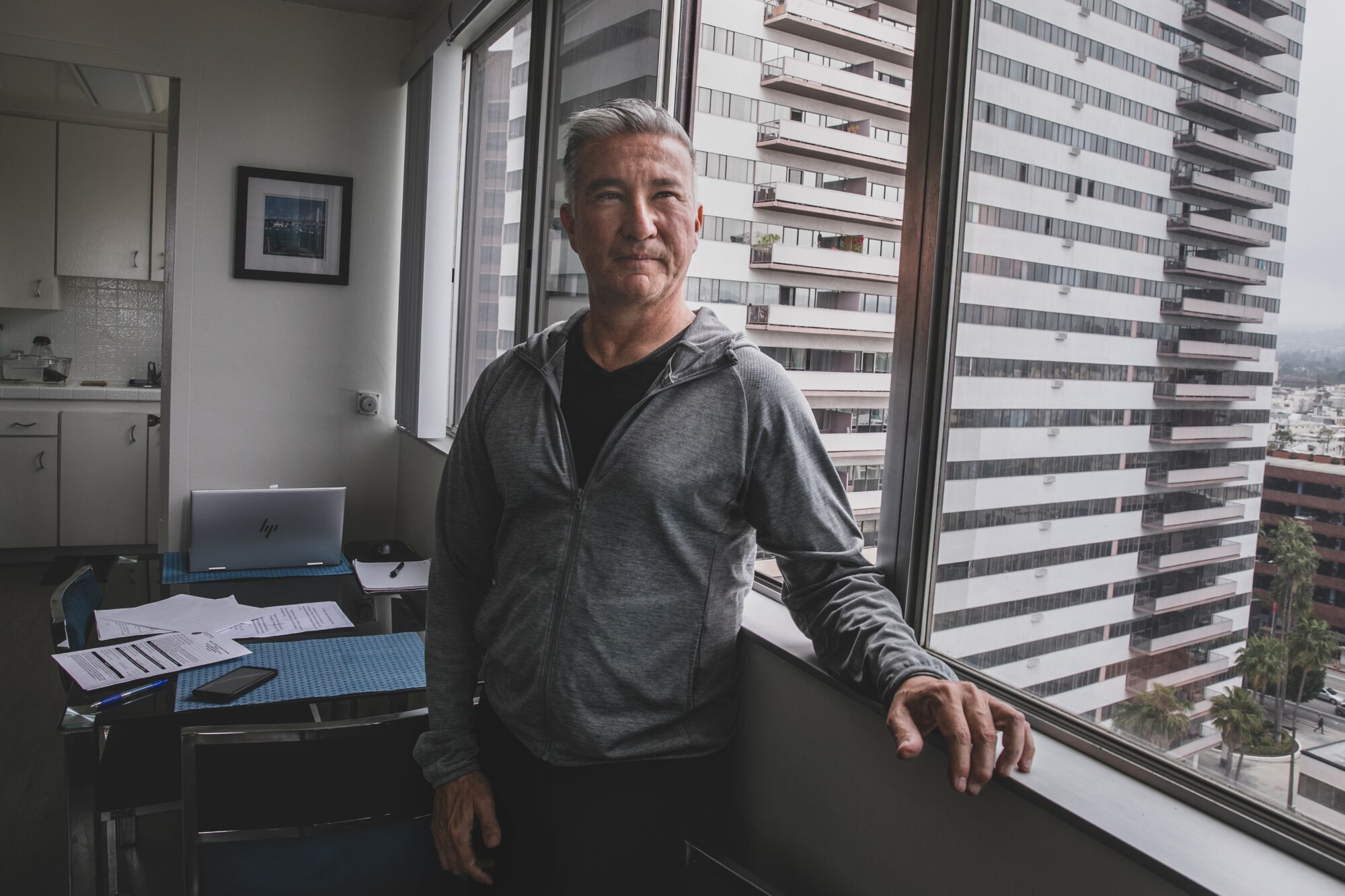Librarian Miki Goral has lived in the massive Westside residential complex Barrington Plaza for more than three decades. She swims in the large heated pool nearly every day and, from her one-bedroom apartment on the 10th floor, she has a view of the ocean. The building is a 15-minute bus ride from her job at UCLA and it’s rent-controlled, allowing her to retain some certainty over housing costs even as rents in the neighborhood have skyrocketed.
Like many of the Plaza’s long-term tenants, Goral had planned to stay for many more years.
This month, she learned that she and each of the residents of the complex’s 577 occupied units were being evicted so that the owner could install fire sprinklers and other safety upgrades. Most were given four months to leave, though Goral and others who are at least 62 or disabled can take up to one year. But Goral can’t imagine leaving.
“I don’t want to move,” she said. “I’ve been here for 34 years. It’s my home.”
Three months after the end of pandemic-era protections limiting the ability of landlords to evict tenants, the owner of Barrington Plaza has initiated one of the largest mass evictions in L.A. in recent years, pushing hundreds of Westside tenants out of their homes at the same time that the city grapples with a housing crisis.
Landlord Douglas Emmett Inc. says the move is necessary to install the sprinklers and other safety equipment in a complex with a history of dangerous fires. It has invoked the Ellis Act, which allows landlords to evict rent-stabilized tenants to remove units from the rental market.
Some tenants are already in the process of leaving, facing a significant jump in rent and the potential cruel irony that their own evictions — hundreds of Barrington residents dumped into the market at once — might drive up prices even more.
But Goral and others believe the company is improperly applying the law and that it can make the safety upgrades without permanently displacing them. They say they will fight to stay.
“In a period where we’re dealing with homelessness throughout the city and county, it’s a major issue that this company would suddenly put almost 600 people on the housing market to compete for housing,” Goral said. “It’s not a sensible thing to do.”
Housing officials say the city has little discretion once a property owner says they are taking a property off the rental market under the Ellis Act but that they are working to help residents relocate. City rules require landlords to pay tenants relocation assistance, amounts that range from about $9,000 to about $23,000, depending on how long they have lived in the apartment, their age, income and other factors.
“The impact of this is profound,” said Greg Good, senior advisor on policy and external affairs for the Los Angeles Housing Department. “There’s no way around that. It’s 577 units, and it will create significant disruption.”

The owner of Barrington Plaza on the Westside has initiated one of the largest mass evictions in L.A. in recent years.
(Jason Armond / Los Angeles Times)
When it opened in 1962, Barrington Plaza was celebrated as the tallest residential complex west of Chicago and the biggest urban renewal project ever insured by the Federal Housing Administration. There were extensive gardens, a nine-hole putting green and a unique intercom system that allowed residents to dial two digits to call down for maids, sitters and caterers.
Over the decades, the apartments would change ownership multiple times and residents would raise repeated safety concerns at the complex, which was exempted from laws requiring fire sprinklers because of when it was built.
On New Year’s Day in 1971, a Christmas tree caught fire, causing the building to be evacuated and the elevators to be removed from service for several days. In 2013, another fire injured several people, including a toddler, and displaced the residents of dozens of units. And in January 2020, another fire left a 19-year-old exchange student dead and several others injured. News stories featured images of a man clinging to the outside of the building several stories up as he tried to escape the blaze.

Firefighters look out from a charred balcony after putting out a fire at Barrington Plaza in 2013.
(Genaro Molina / Los Angeles Times)
After that fire, eight floors in the complex’s tallest building were red-tagged, and they have remained vacant since.
Eric Rose, a public relations executive working for Douglas Emmett, said in written responses to questions that when the company submitted plans to rebuild the damaged floors, the city conditioned its approval on the installation of sprinklers and other safety equipment throughout Barrington Plaza’s three towers.
Those changes cannot be done without vacating the three towers at the same time, Rose said, because building systems are shared among them and “structural changes, including changes to ceilings and walls, need to be made in order to carry the weight of the sprinkler system.”
This month, the company notified the city that it would withdraw the complex from the rental market under the Ellis Act, a 1985 state law that allows landlords to evict tenants in rent-stabilized apartments if, for instance, they are taking the building off the rental market to convert the units to condos.
Under city rules, owners invoking the Ellis Act must seek “in good faith” to remove it “permanently from rental housing use.”
Tenants and advocates say they believe the long-term plan is to rent the apartments once again. Because of that, they say, the evictions would be an improper use of the law.
“They want to renovate it. And they clearly want to re-rent it, and that’s not what the Ellis Act is about,” said tenant rights advocate Larry Gross, of the Coalition for Economic Survival.
He said the company should have used the city’s Tenant Habitability Program, under which landlords doing major renovations can temporarily relocate residents to comparable units until the work is done.
Rose says the Tenant Habitability Program is typically used for renovations that last days or months, not years.
“At this time, the owners of Barrington Plaza are removing the units from the market and have options as to how those units will change, be rehabilitated through new life-safety measures or become something different,” Rose said.
He suggested that the apartments could eventually return to the rental market under rules laid out by the city.
Any rehabilitation of the complex will take years, he said, and “after that time, if the units were brought back onto the rental market, the owner would follow the obligations relative to former tenants as provided in those state and local rules.”
There are no plans to build new condominiums on the site, Rose said.
Residents have struggled to make sense of the lack of clarity about the building’s future.
Attorney Nima Farahani, who has conducted legal clinics and met with several of the Barrington tenants, said that under the Ellis Act, “if you really, in good faith, can’t be a landlord, you can stop being a landlord.”
But, he said, “you’ve got to go out of the rental business. End of story.”
Under the law, if within two years a landlord rents an apartment vacated under the Ellis Act, they can be liable to former tenants for damages.
But after that, the consequences are less severe. If they rent within five years of the evictions, they must offer tenants a right of return with the same rent that they were paying when they were evicted, plus certain approved increases.
If the company rents again between five and 10 years, it must offer a right of return but can charge a market rate rent.
Advocates say that after two years, most residents will have resettled and be unlikely to return.
Residents have formed a tenants association, and many are preparing for fight the eviction. Some see it as part of a larger effort to protect affordable housing in Los Angeles.
A majority of the building’s tenants — who include a mix of retirees, working-class and white-collar workers and students — moved into the building in recent years. But more than 100 residents have lived at the Plaza for five or more years, according to city records. The median length of residency among those long-term tenants was 12 years. Some have lived there since the 1960s.
But even among those who have moved in more recently, there are residents who don’t want to go. Many say they chose the building because it was rent-stabilized, and that finding something similar will be next to impossible.
Jacqui Fournier, 56, moved in to Barrington Plaza during the pandemic, in August 2020. She pays $1,595 for a studio on the 10th floor, a rate she believes was lower than it might have been under normal circumstances.
“We want to stay in our homes,” she said. “We cannot get, on the Westside, a comparable apartment at what we are paying now.”
The going rate for a studio apartment in the vicinity of Barrington Plaza is about $2,600, said Ryan Patap, senior director of market analytics with CoStar, which tracks real estate data.
The median rent paid by tenants at Barrington is $2,295, according to city data. That amount includes studios, one-bedroom and two-bedroom apartments.
Patap said it is possible that the large-scale evictions themselves could cause moderate rent increases in the surrounding neighborhood.
“This many renters probably would push up the rents. But to what extent, it’s hard to quantify,” he said.
At the same time, it’s likely that many tenants won’t be able to remain in the neighborhood at all, because they wont be able to afford it, he said.

Chuck Martinez poses for a portrait inside his studio at Barrington Plaza on May 15.
(Jason Armond/Los Angeles Times)
Chuck Martinez, a driver for Uber Eats, moved into Barrington Plaza in 2021. He knew it was the right place when he learned it was rent stabilized.
“I thought, ‘I’m going to need this,’ ” he said. “Looking back, I was happy I made the decision because now we’re dealing with inflation. The price of everything has gone up.”
He pays $1,850 a month for his studio on the 12th floor. From the windows that wrap around the corner unit, he can see Griffith Observatory and the Getty Center on a clear day.
“It’s a million-dollar view for $1,850,” he said.
For the last couple of weeks, when he’s not working he’s been meeting with other tenants, lawyers and advocates, trying to figure out if there is a way for him and others to avoid leaving.
“I’m trying to save myself from losing my rent-stabilized apartment,” he said. “It’s the only way to try to keep something livable.”
- SEO Powered Content & PR Distribution. Get Amplified Today.
- PlatoAiStream. Web3 Data Intelligence. Knowledge Amplified. Access Here.
- Minting the Future w Adryenn Ashley. Access Here.
- Buy and Sell Shares in PRE-IPO Companies with PREIPO®. Access Here.
- Source: https://www.latimes.com/california/story/2023-05-26/westside-renters-barrington-plaza-mass-eviction



